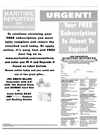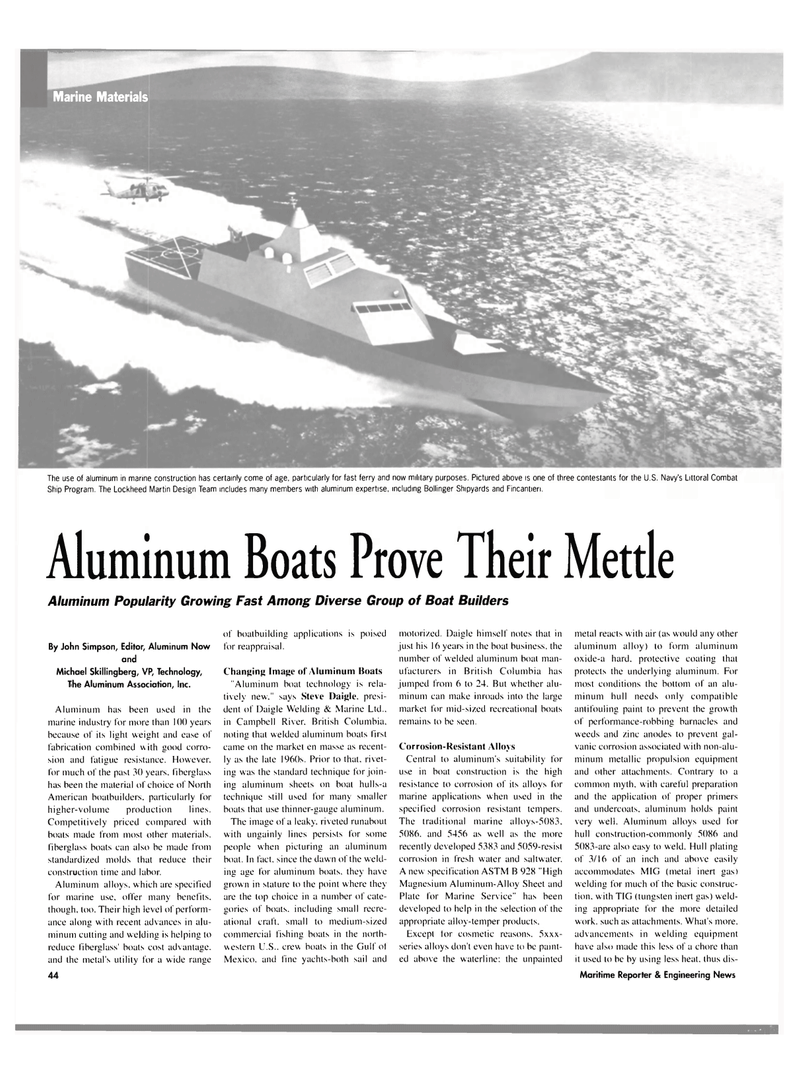
Page 49: of Maritime Reporter Magazine (February 2004)
The Tanker Yearbook: ATB Edition
Read this page in Pdf, Flash or Html5 edition of February 2004 Maritime Reporter Magazine
Marine Materials
The use of aluminum in marine construction has certainly come of age, particularly for fast ferry and now military purposes. Pictured above is one of three contestants for the U.S. Navy's Littoral Combat
Ship Program. The Lockheed Martin Design Team includes many members with aluminum expertise, including Bollinger Shipyards and Fincantieri.
Aluminum Boats Prove Their Mettle
Aluminum Popularity Growing Fast Among Diverse Group of Boat Builders
By John Simpson, Editor, Aluminum Now and
Michael Skillingberg, VP, Technology,
The Aluminum Association, Inc.
Aluminum has been used in the marine industry for more than 100 years because of its light weight and ease of fabrication combined with good corro- sion and fatigue resistance. However, for much of the past 30 years, fiberglass has been the material of choice of North
American boatbuilders. particularly for higher-volume production lines.
Competitively priced compared with boats made from most other materials, fiberglass boats can also be made from standardized molds that reduce their construction time and labor.
Aluminum alloys, which are specified for marine use, offer many benefits, though, too. Their high level of perform- ance along with recent advances in alu- minum cutting and welding is helping to reduce fiberglass' boats cost advantage, and the metal's utility for a wide range 44 of boatbuilding applications is poised for reappraisal.
Changing Image of Aluminum Boats "Aluminum boat technology is rela- tively new." says Steve Daigle. presi- dent of Daigle Welding & Marine Ltd.. in Campbell River. British Columbia, noting that welded aluminum boats first came on the market en masse as recent- ly as the late 1960s. Prior to that, rivet- ing was the standard technique for join- ing aluminum sheets on boat hulls-a technique still used for many smaller boats that use thinner-gauge aluminum.
The image of a leaky, riveted runabout with ungainly lines persists for some people when picturing an aluminum boat. In fact, since the dawn of the weld- ing age for aluminum boats, they have grown in stature to the point where they are the top choice in a number of cate- gories of boats, including small recre- ational craft, small to medium-sized commercial fishing boats in the north- western U.S.. crew boats in the Gulf ot
Mexico, and fine yachts-both sail and motorized. Daigle himself notes that in just his 16 years in the boat business, the number of welded aluminum boat man- ufacturers in British Columbia has jumped from 6 to 24. But whether alu- minum can make inroads into the large market for mid-sized recreational boats remains to be seen.
Corrosion-Resistant Alloys
Central to aluminum's suitability for use in boat construction is the high resistance to corrosion of its alloys for marine applications when used in the specified corrosion resistant tempers.
The traditional marine alloys-5083, 5086. and 5456 as well as the more recently developed 5383 and 5059-resist corrosion in fresh water and saltwater.
A new specification ASTM B 928 "High
Magnesium Aluminum-Alloy Sheet and
Plate for Marine Service" has been developed to help in the selection of the appropriate alloy-temper products.
Except tor cosmetic reasons. 5xxx- series alloys don't even have to be paint- ed above the waterline: the unpainted metal reacts with air (as would any other aluminum alloy) to form aluminum oxide-a hard, protective coating that protects the underlying aluminum. For most conditions the bottom of an alu- minum hull needs only compatible antifouling paint to prevent the growth of performance-robbing barnacles and weeds and zinc anodes to prevent gal- vanic corrosion associated with non-alu- minum metallic propulsion equipment and other attachments. Contrary to a common myth, with careful preparation and the application of proper primers and undercoats, aluminum holds paint very well. Aluminum alloys used for hull construction-commonly 5086 and 5083-are also easy to weld. Hull plating of 3/16 of an inch and above easily accommodates MIG (metal inert gas) welding for much of the basic construc- tion. with TIG (tungsten inert gas) weld- ing appropriate for the more detailed work, such as attachments. What's more, advancements in welding equipment have also made this less of a chore than it used to be by using less heat, thus dis-
Maritime Reporter & Engineering News

 48
48

 50
50
